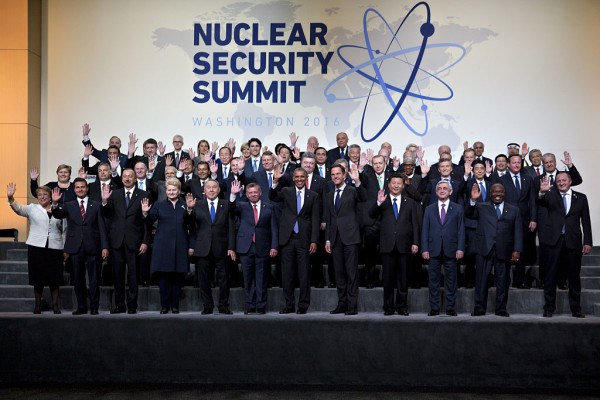With the fourth Nuclear Security Summit (NSS), aimed at safeguarding nuclear materials that terrorists could use to develop nuclear weapons or small “dirty bombs,” having recently wrapped up in Washington, D.C., we asked our program editors:
Is the Nuclear Security Summit an effective forum for addressing the threat of nuclear terrorism?
Khalid Mahdi: Nuclear Terrorism Is A Bigger Threat Than We Think
Program Editor, NATO’s Arc of Crisis
In his 2010 address at Hradcany Square in Prague, U.S. President Barack Obama emphasized the importance of ensuring that global terrorist groups like al-Qaeda are never able to acquire a nuclear weapon. Speaking on the issue, the President announced the beginning of a host of summits on nuclear security, aimed at securing all “vulnerable nuclear material around the world within four years…” Four successive Nuclear Security Summits (NSS) later, substantial progress has been made in both securing and eliminating large stocks of weapons-usable nuclear materials.
Since the establishment of the NSS process, more than 260 commitments (or “gift baskets” in the parlance of the NSS) by more than 50 world leaders have been made to prevent nuclear terrorism and counter nuclear smuggling, while significant reductions in weapons-usable plutonium and highly enriched uranium have occurred in over 30 countries to date. Given the summit’s role in garnering substantial enthusiasm and commitment towards securing nuclear materials, and that global terrorism is on the rise, the continued presence of these forums is of the utmost importance.
As a substantial slew of terror-related incidents in Belgium and France over the past few months have demonstrated, groups like ISIS have both the means and will to inflict mass casualties at any time and any place. If the bombings in Brussels scared the living daylights out of you, can you imagine the devastation that a nuclear-armed ISIS could inflict? That is definitely a reality that no world leader should ever face. However, given the continued storage of large quantities of nuclear materials for civilian and military applications, including in states with unstable governance and unreliable security forces, the threat of such an attack still looms.
As the Boston Marathon bombers have shown, it doesn’t take much for terrorist groups to build a deadly bomb. The launching of a nuclear attack is not that far off. All it takes is a finite amount of nuclear material to build a radiological dispersion device or “dirty bomb,” which combines nuclear material with traditional explosives, to inflict substantial property damage or public chaos. As U.S. Secretary of State John Kerry eloquently summed up in his remarks at an NSS working dinner on March 31, “…we know that there are extremists out there who are probing for signs of complacency, looking for that chink in the armor, looking for inattention or sloppiness or corruption…If you’re a terrorist, you only have to get it right for 10 minutes or an hour or a few hours.”
If I still haven’t convinced many of you, then consider the prevalence of security breaches in various parts of the the U.S. and Europe:
- In December 2014, Moldovan authorities uncovered a nuclear-smuggling ring and confiscated a 200-gram mixture of uranium 235 and 238 (materials that could easily be enriched to weapons-grade) that was reportedly shipped from Russia.
- In 2012, in another frightening instance of nuclear sabotage, an 82-year-old nun and her two accomplices broke into a Y-12 nuclear weapons plant in Oak Ridge, Tennessee, a facility that was regarded as the most secure in the world.
- In a raid of the residence of an ISIS-linked suspect in the November 2015 Paris attacks, Belgian police found surveillance footage of a senior official at a nuclear center in Belgium, in what authorities speculated was part of a plot to capture nuclear materials.
The point here is that while substantial progress has been made in securing nuclear materials from nefarious acquisition, a number of threats to nuclear security still exist. Rogue states like North Korea are expanding their nuclear arsenals, while cyber-space continues to threaten the security of nuclear facilities worldwide. With the summits concluded, as noted by the Arms Control Association, political will on nuclear security “will be in danger of backsliding to a largely technical issue for states.”
Aleksi Korpela: One of Many Mechanisms To Counter Nuclear Proliferation
Program Editor, Procurement
The Nuclear Security Summit is one piece in a larger counter-proliferation puzzle. A collection of institutional frameworks, organizations, and legal regimes function to limit the dangers of nuclear proliferation and enhance the security of nuclear materials and facilities. These include the IAEA, the Zangger Committee, the Nuclear Suppliers Group, and the Proliferation Security Initiative—among many others. What the NSS offers is a high-profile forum for states to enter into legal and institutional frameworks, raise proliferation concerns, and compartmentalize collaboration on nuclear counter-proliferation.
As a result of the Nuclear Security Summits, important progress has been made to increase security measures related to nuclear material and facilities. Stockpiles of high-enriched uranium and plutonium have been secured and export-control measures have been implemented across dozens of countries. The Summit helps to apply pressure on states through indirect public diplomacy to implement agreed-upon security measures.
Despite the doom and gloom that comes with warnings about nuclear terrorism, articulating the threat in realistic terms is difficult. Recent incidents reveal just how close terrorist groups have come to compromising the security of nuclear materials in various countries, which suggests the threat is immediate and real. However, the overall likelihood of a terrorist group acquiring a nuclear device is low. It is extremely improbable that terrorists could actually manufacture, smuggle, and detonate a nuclear device. Statistically, plastic explosives such as Semtex pose a more immediate challenge due to low detectability and relatively easy acquisition.
That being said, the NSS is an important cog in the global nuclear counter-proliferation effort, and one small aspect of the endeavour to decrease the overall risk of terrorism. Nevertheless, in light of the substantial damage nuclear terrorism could have, it is the obligation of the international community to ensure that this improbable scenario is closer to an impossibility—and the NSS is one such way to ensure this.




